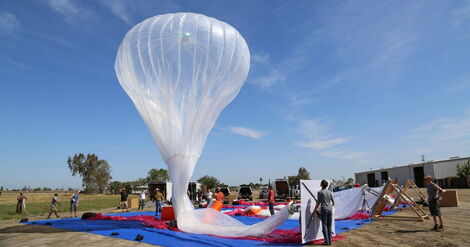Telkom Kenya and Google Loon on Tuesday, July 7, announced the availability of mobile internet service via the Loon technology to Kenyans, starting July 2020.
The milestone came as the project partners approach the completion of the network integration tests, which have seen them successfully assess service quality across their infrastructure and respective networks.
In one field testing session in late June, Loon and Telkom registered an uplink speed of 4.74 Mbps, a downlink speed of 18.9 Mbps, and latency of 19 milliseconds (ms).
In this and subsequent testing, the service was used for applications such as email, web browsing, data calls e.g via WhatsApp, video calls, and YouTube.
Even with Loon’s advanced machine learning algorithms that work to keep the balloons up, there are times when certain impediments such as wind patterns and restricted airspaces, could result in intermittent service availability.
Loon and Telkom are working together to limit any potential service disruptions and improve the user’s experience.
As Loon gains more experience flying in Kenya, and dispatches more balloons to the service region, it is expected that service consistency will increase.
In addition, with the Loon technology being a solar-powered solution, customers will get to experience mobile internet service availability from 6 a.m. to 9 p.m.
The service will initially cover a region spanning nearly 50,000 sq.km., including the areas of Iten, Eldoret, Baringo, Nakuru, Kakamega, Kisumu, Kisii, Bomet, Kericho, and Narok.
“This is an exciting milestone for internet service provision in Africa and the world, more so that the service will pioneer in Kenya. This being purely a data service and with the continued migration of communication towards data-supported platforms, the internet-enabled balloons will be able to offer connectivity to the many Kenyans who live in remote regions that are underserved or totally unserved, and as such remain disadvantaged.
“This new technology will also complement Telkom’s ongoing strategy to further widen our network coverage, enabling us realise our brand promise; to be Kenya’s preferred data network,” Telkom Kenya’s Chief Executive Officer, Mugo Kibati explains.
With the Covid-19 pandemic, the ensuing crisis has made online education, and other crucial interventions to the country such as telemedicine as well as digitised- and automated platforms to enable the consumer still access service, the new normal.
“We remain intent on expediting all projected timelines with the primary objective being to further shorten the total time taken towards progressive service deployment,” Kibati added.

“Without the support and engagement by various government agencies, today would not be possible. We are incredibly grateful to the many governmental stakeholders who helped usher in Africa’s first application of this innovative technology.”
Press Play: ICT Cabinet Secretary @mucheru, Telkom Chairman, @eddy_njoroge and CEO @mugokibati video call His Excellency, President Uhuru Kenyatta on the Loon 4G data signal in Radat, Baringo County. #TelkomLoon pic.twitter.com/xlDg2oUL1Y
— Telkom Kenya (@TelkomKenya) July 8, 2020
To provide service in Kenya, Loon and Telkom are utilising a fleet of around 35 or more separate balloons that are in constant motion in the stratosphere above eastern Africa.
“In light of the spread of COVID-19, Telkom and Loon are working as fast as we can to realise service deployment. This will also enable us to support the Kenyan government’s efforts to manage the current crisis in the short-term, and to establish sustainable operations to serve communities in Kenya in the long-term.
“The Loon service has the capacity to bring about positive impact; connecting targeted communities to emergency services, as well as ensuring enhanced and alternative communication options during this time,” Westgarth added.
Credit: Source link